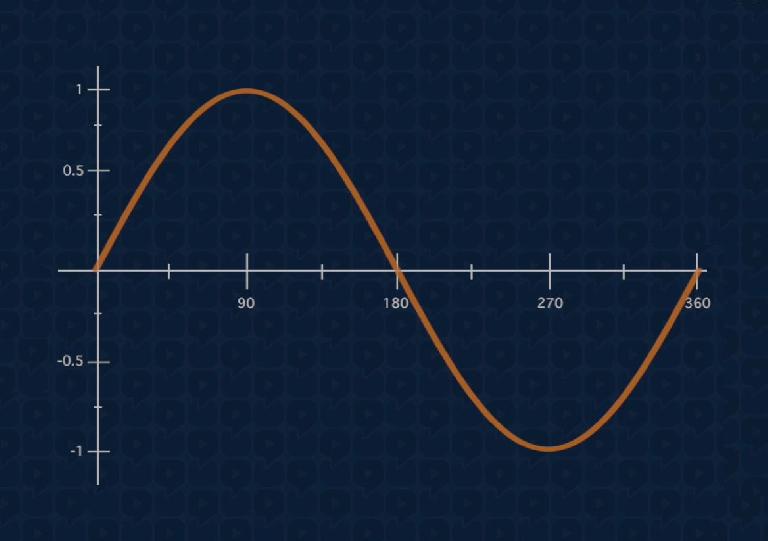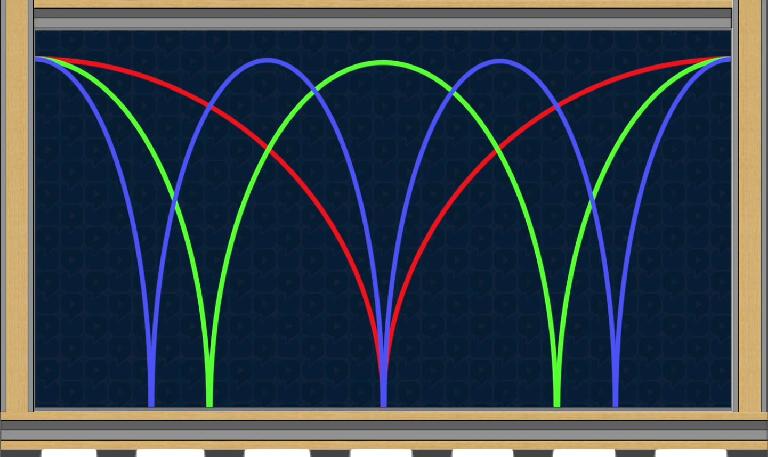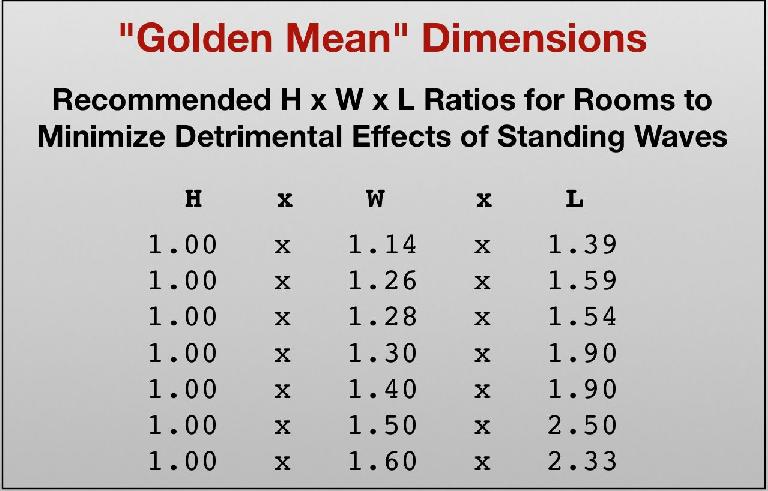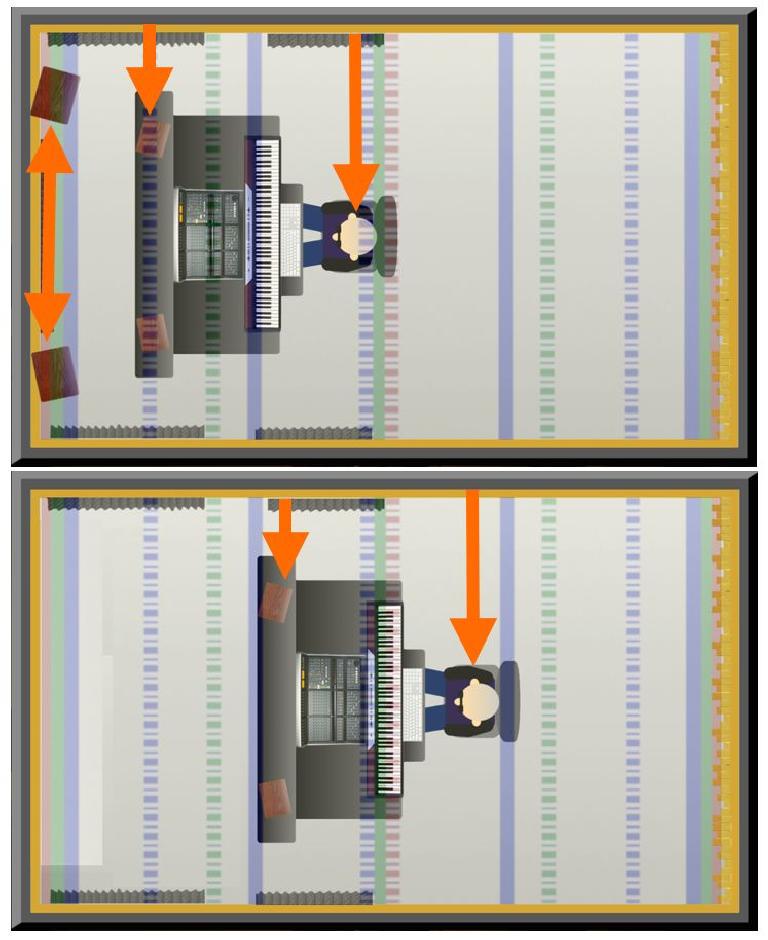One of the most persistent problems faced by small studio operators is low-frequency irregularities in the room itself. Since every decision we make in recording and mixing is based on what we hear from the studio monitors, when the room colors that response, the end result can often be seriously flawed mixes, and low-frequency coloration is by far the most problematic type of room coloration. Plenty has been written about this issue, but with new engineers and mixers constantly coming up, it’s always worth taking another look at this problematic acoustic phenomenon.
Sound wave behavior: the basics
First, a little (necessary) background. Sound waves in the air are periodic variations of air pressure, caused by a vibrating object (like guitar/piano strings, drum heads, lips & vocal chords, etc). The Frequency of vibration corresponds to the musical pitch, and the Amplitude (the intensity of the air pressure variations) corresponds to loudness. Waveshape - the pattern of vibration - is more complex, and is key to understanding low-frequency room issues. The most basic pattern of vibration consists of cycles of simple back and forth motion - this kind of wave is called a Sine Wave, and it’s a “pure tone” - a steady, bland sound.
Its Frequency is measured in Cycles Per Second (cps), or, more commonly, Hertz (Hz). Humans can hear Frequencies from around 20 Hz up to 20 kiloHertz (20 thousand Hertz), but the low frequencies that cause room issues are typically below 200-300 Hz, depending on the size of the room.
Real instruments and voices tend to vibrate at many sine wave frequencies simultaneously, and these frequencies are mathematically related. The lowest is called the Fundamental frequency, and this is the one that corresponds to the perceived pitch of the note. The others are multiples of this Frequency (2x, 3x, 4x, 5x, etc), and are called Harmonics. (It’s more complex than this, but I’m only going to cover as much detail as is relevant to low-end room issues). Harmonics are not perceived as separate pitches, since they all stop and start together with the Fundamental - instead they provide timbre, or tone, for the sound, which is what gives an instrument or voice its distinctive character.
Sound waves in a room reflect off surfaces in the room (walls, floor, ceiling), interacting and interfering with themselves and other waves. This is a normal part of acoustic sound in an enclosed space, and at midrange and higher frequencies it can contribute to a desirable ambience. But low frequencies are another matter.
A physical sound wave in a room has a wavelength - the distance the wave travels in the room during one cycle of vibration. Higher frequencies have short wavelengths (a few inches), and their reflections and interference are spread throughout the room (this may need to be addressed, but that’s the subject of a separate discussion). But the wavelengths of low frequencies are long, sometimes as long as or longer than the dimensions of the room itself. When these waves reflect and interfere, this causes irregularities in bass response at different locations in the room - these are called Standing Waves, or Room “Modes”. Fortunately, these irregularities are predictable.
Standing Waves, aka Room Modes
When a long low frequency wave reflects off, say, a wall, back onto itself, the original direct wave (from the vibrating source) and the reflected wave will combine. Each cycle of a wave consists of a (positive) peak (increase in air pressure, or compression (of air molecules), and a negative peak (or trough), a decrease of air pressure (rarefaction). Just as with electrical waves, when two positive peaks or two negative peaks coincide, they reinforce each other; but if a positive peak coincides with a negative peak, there’s a cancellation.
The same thing happens acoustically, when a reflected wave meets the original - direct and reflected waves will potentially cancel and/or reinforce. For example, if this occurs halfway through a cycle, with positive and negative peaks coinciding exactly, the wave will be cancelled out completely (in theory - in real rooms, the effect is more complex). With long low frequencies, these cancellation and reinforcements will occur at different fixed locations in the room (hence the term “Standing” Wave), and the specific frequencies that are affected will be ones that are multiples of the room’s dimensions (HxWxD).
If you’re sitting in one of those spots, the sound you hear will be subject to low-frequency tonal irregularities that are only present in that particular spot in that particular room. Typically, an engineer/mixer doesn’t realize this, and tries to correct for them (with EQ), but those corrections are also only valid for that one spot in that one room! When the mix is played elsewhere, overly boomy or thin or irregular bass, that’s been EQ’d into the audio, will make the mix sound bad - engineers would say that mixes made in that room don’t “travel” well.
Calculating Standing Waves
These Standing Waves/Room Modes will occur between all parallel surfaces - front & rear walls, side walls, and floor & ceiling - resulting in spots in the room where the bass at certain frequencies will be much louder than normal (boomy), and other spots where certain frequencies will be cancelled out (partially or almost completely). The areas of cancellation are called Nodes, and the areas of reinforcement are called Antinodes. So if some notes in a bass line happen to coincide with those frequencies at the mixer’s listening position, the level and tone of the bass will vary subtly or dramatically, causing the mixer to reach for the EQ or compressor, creating the “traveling” problem described above.
Fortunately, Room Modes can be predicted/calculated for a room of given dimensions, using a simple formula: 1130÷2L (where 2L = room dimension x 2, and 1130 is the speed of sound). There isn’t room here to get deep into the formulas and calculations, but there are plenty of technical sources that delve into the details. With a little simple math, you can figure out the specific frequencies at which Standing Waves will occur in a particular room. But keep in mind, since normal complex waves are made up of Harmonics, Standing Waves will occur at not only the Fundamental frequencies for each room dimension, but at the next few Harmonics as well (up to around 200-300 Hz, where the irregularities start to smooth out). And the locations in the room where the effects of the various Harmonics occur differ for each Harmonic, further complicating matters.
The particular spots in the room where the audible reinforcements (Antinodes, boomy bass) and cancellations (Nodes, weak bass) will be located are also predictable. As you can see in Fig 3, the first (primary) Modal frequency between two walls (red) will have a strong Antinode (bass buildup) at the walls, and a strong Node at the center of the room (between those two walls). The second Harmonic (green) will also have a buildup at the walls - in fact all the Harmonic Modes will have an Antinode at the walls, which is why experienced engineers avoid sitting with their backs up against a wall, and often prefer monitor placement away from room boundaries. But this Mode will also have an Antinode at the center position, and Nodes halfway between center and walls. Fig 3 shows the locations of the Nodes & Antinodes for the first three Harmonic Modes between one wall - and remember the same anomalies will also occur between the other pair of walls, and between floor & ceiling!
Addressing Room Modes
Standing Waves/Room Modes occur in all rooms, but in larger rooms, the worst effects are often at frequencies low enough to be less problematic. But in smaller rooms (for example, 10 x 14, or 12 x 16), the Room Modes typically form at frequencies right in the middle of the musical bass range (50-200 Hz), and can easily trip up unwary mixers. So what can/should the studio operator who wants to be able to trust what he’s hearing do? Well, unfortunately the best solutions may involve expensive or intrusive (space-reducing) construction, but there are simpler ways to at least minimize the detrimental effects of this phenomenon.
If a studio room is being constructed from scratch, one approach is to select room dimensions that minimize the negative effects of Standing Waves. The worst room (vis-a-vis Standing Waves) would be a cube - with equal distances between both pair of walls and floor and ceiling, three sets of Room Modes will form at the same frequencies, exacerbating the problem. The ideal room would have dimensions that space out the Modes more evenly in terms of frequencies, so that the effects are minimized - Room Modes from each dimension would avoid Modes from the others, for a more even response, with less potential for really troublesome “hot spots”. There are many recommended room dimensions, which are referred to as “Golden Mean” room ratios - Fig 4 lists several of these.
Golden Mean room ratios don’t eliminate Room Modes, but they can minimize their effects; to eliminate them you’d need to have wall cavities that affect low frequency reflections - these are commonly referred to as “Bass Traps”. A Bass Trap is a wall cavity tuned to a specific depth (1/4 wavelength of a Room Mode), and it can effectively dampen that Room Mode, but you need space behind the wall to implement it, which may reduce overall room size (possibly a dealbreaker in smaller rooms). Other physical solutions include Helmholtz Resonators and Diaphragmatic Absorbers - all of these need to be precisely tuned to the offending frequencies to be effective. For those handy with power tools, there are plenty of books on studio acoustics that include formulas and instructions for rolling your own. You can also buy standalone traps, which are typically placed in the corners of the room - once again, you’ll need to provide the manufacturer with the room dimensions, so traps can be properly tuned to that particular space, but these can work quite well.
No-cost approaches
If all of these options are beyond your capabilities or your means, there are a few simple steps you can take to at least avoid the worst effects of room modes. Number one is to simply be aware of them - don't blindly trust the bass you hear in your studio! Then familiarize yourself with the room’s low-end anomalies in three ways: First, on the less-technical side, “walk” the room - move slowly between walls while playing suitably bass-heavy material, and take note of where the low end peaks & dips are. Second, play a lot of commercial recordings, listening at your mix position, to get to know what properly-balanced & EQ’d bass should sound like in that space.
Third, do a little homework - grit your teeth and do the math to calculate and map out the worst of the Room Modes. Then arrange the position of the monitor speakers and, especially, the mixing position - the “Sweet Spot” - to avoid problem zones. For example, placing the monitors and setting the Sweet Spot somewhere between the various Nodes & Antinodes (and away from walls and room center!) can provide a much more reliable and trustworthy response for mixing (see Fig 5).
Wrap-up
I’m out of space, but I’d encourage anyone who operates their own small studio, and who feels their mixes may be suffering from bass-related issues, to do some further reading. If you google “recording studio acoustics” you’ll find dozens of sites that address these issues, and searching the same phrase on Amazon will bring up several highly recommended books for intrepid DIY-ers. At the very least, take a little time to check out your room and arrange things to minimize the ill-effects of Standing Waves/Room Modes - your mixes will travel better for it!






 © 2024 Ask.Audio
A NonLinear Educating Company
© 2024 Ask.Audio
A NonLinear Educating Company
Discussion
I have a question.
Do you know if Sonarworks speaker and room calibration software would be useful in solving some of the low freq issues!?
Thanks
From what I can see, the Sonarworks product is focused on using EQ to address room issues.. That can be an effective approach, although it won't really really eliminate the room modes themselves, just compensate for them. Though the corrected balance response may provide a better response at the sweet spot, other listeners in the room won't necessarily benefit from this -- that's also the case with positioning the monitors & sweet spot to avoid the node & antinode locations -- so the best solution in a particular case may depend on whether critical listening needs to be done by only one person (in the primary listening position) or by others as well. I've always felt that addressing room modes at the source -- if possible -- is preferable; if bass trap construction isn't a viable option (if the room is already built and in use), then I'd be inclined look to those standalone wall- or corner-mounted products. But as you suggested, the first step would be to simply calculate the frequencies and locations of the primary room modes (as per the formulas & instructions available in various places), and do some listening tests to determine just how strong the effects are and to what degree your current monitoring experience is colored by them -- and then take it from there..
Cheers,
Joe
Your articles are really great.
Thanks Joe.
Best
Solic from Sunnyside, Queens NY.
Want to join the discussion?
Create an account or login to get started!